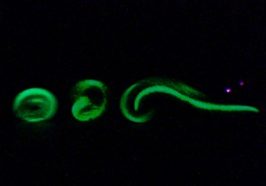Roll, robot, roll
Caterpillars inspire researchers to build a robot that rolls to safety

There’s no such thing as a natural robot. Robots aren’t alive, they don’t grow, and they need people and technology to get around. But engineers, the human inventors of these machines, don’t ignore nature. In fact, these researchers are often inspired by natural events. Many clever gadgets and devices imitate the workings of nature.
The inventors of a new robot called GoQBot drew inspiration from caterpillars. To escape predators or other dangerous situations, some caterpillars curl into a hoop and roll away. They do this trick in a split second and make a fast getaway — reaching speeds of nearly 8 inches per second. That’s one of the fastest known wheeling motions in nature, say GoQBot’s inventors.
“You poke the animal and you don’t know where it’s gone,” Huai-Ti Lin told Science News. “It’s wicked fast.” Lin invented GoQBot while working on his Ph.D. in biology at Tufts University in Medford, Mass. He is now a researcher at Harvard University.
On the outside, Lin’s GoQBot looks a lot like a large caterpillar. It’s light green and just under four inches long. On the inside, however, GoQBot looks less like its inspiration. A caterpillar’s segmented body contains intestines and other small organs. GoQBot is made of a rubbery material called silicone and has metal coils inside.
When electrical currents travel through those metal coils, GoQBot snaps into action. Like its caterpillar counterpart, the robot rolls up and races away. Satyandra Gupta told Science News that robots that crawl on many legs are slowed down because they have so many joints. (Joints are spots where different parts come together, like people’s knees.) A robot that rolls, on the other hand, can reach high speeds quickly. Gupta, who did not work on GoQBot, is the director of the Maryland Robotics Center at the University of Maryland in College Park.
“Once you get into a ball and rolling, you get dramatic increases in speed,” Gupta told Science News. “This is an exciting development.”
The new robot is an example of biomimetic technology, which includes devices that imitate, or mimic, something in nature. Lin told Science News he invented GoQBot to better understand how caterpillars move. In a recent study, he and his colleagues report that they’ve already started to learn about the bugs’ ability to roll. They’ve also estimated how much power a caterpillar needs to perform the maneuver.
But there’s one way in which GoQBot is decidedly not like a caterpillar. No matter how much current Lin and his colleagues pump through the coils, the GoQBot will never morph into a butterfly.
POWER WORDS (adapted from the Oxford New American Dictionary)
biomimetics Artificial methods of design or construction that mimic biochemical processes.
robot A machine capable of carrying out a complex series of actions automatically, especially one programmable by a computer.
biology The study of living things.
silicone Polymers that have a chemical structure based on chains of alternate silicon and oxygen atoms, with carbon-containing groups attached to the silicon atoms.
polymer A material that’s made of a long string of similar molecules bonded together.







